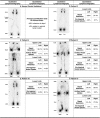The lymphatic phenotype in Turner syndrome: an evaluation of nineteen patients and literature review
- PMID: 25804399
- PMCID: PMC4486366
- DOI: 10.1038/ejhg.2015.41
The lymphatic phenotype in Turner syndrome: an evaluation of nineteen patients and literature review
Abstract
Turner syndrome is a complex disorder caused by an absent or abnormal sex chromosome. It affects 1/2000-1/3000 live-born females. Congenital lymphoedema of the hands, feet and neck region (present in over 60% of patients) is a common and key diagnostic indicator, although is poorly described in the literature. The aim of this study was to analyse the medical records of a cohort of 19 Turner syndrome patients attending three specialist primary lymphoedema clinics, to elucidate the key features of the lymphatic phenotype and provide vital insights into its diagnosis, natural history and management. The majority of patients presented at birth with four-limb lymphoedema, which often resolved in early childhood, but frequently recurred in later life. The swelling was confined to the legs and hands with no facial or genital swelling. There was only one case of suspected systemic involvement (intestinal lymphangiectasia). The lymphoscintigraphy results suggest that the lymphatic phenotype of Turner syndrome may be due to a failure of initial lymphatic (capillary) function.
Figures


References
-
- Wolff DJ, Van Dyke DL, Powell CM: Working Group of the ACMG Laboratory Quality Assurance Committee Laboratory guideline for Turner syndrome. Genet Med 2010; 12: 52–55. - PubMed
-
- Gunther DF, Sybert VP: Lymphatic, tooth and skin manifestations in Turner syndrome. Int Congr Ser 2006; 1298: 58–62.
-
- Matura LA, Ho VB, Rosing DR, Bondy CA: Aortic dilatation and dissection in Turner syndrome. Circulation 2007; 116: 1663–1670. - PubMed
-
- Sybert VP, McCauley E: Turner's Syndrome. N Engl J Med 2004; 351: 1227–1238. - PubMed
Publication types
MeSH terms
Grants and funding
LinkOut - more resources
Full Text Sources
Other Literature Sources
Medical

